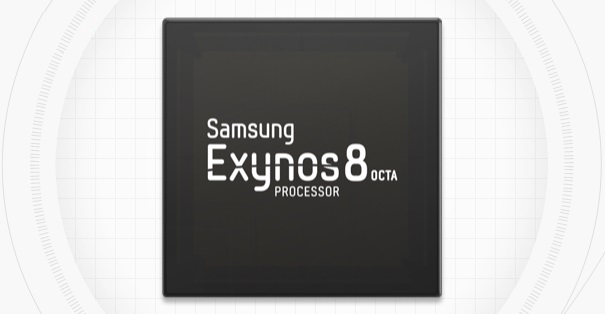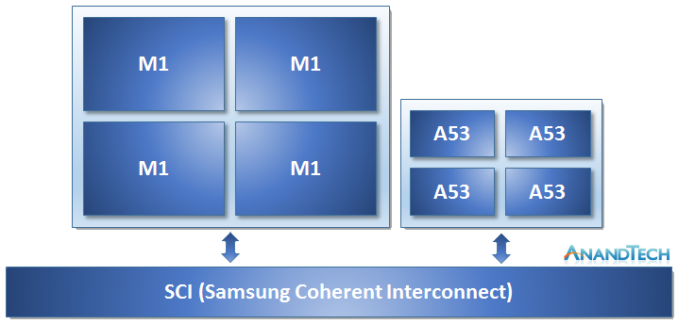Samsung Announces Exynos 8890 with Cat.12/13 Modem and Custom CPU
by Andrei Frumusanu on November 12, 2015 1:50 AM EST- Posted in
- Smartphones
- Samsung
- Mobile
- SoCs
- Exynos 8890
- Exynos M1

In an unexpected and surprise annoucement, Samsung today revealed its new generation flagship SoC - the Exynos 8. The Exynos 8890 to be more specific, is the successor to the Exynos 7420 that we've come to know very well in this year's Galaxy flagships such as the Galaxy S6 or the Note5.
The Exynos 8890 is still an 4+4 big.LITTLE design using four Cortex A53 cores in the little cluster, but on the big cluster we see for the first time Samsung's own custom developed CPU architecture deployed in silicon. The new core, officially called the Exynos M1, is the first fruit of years-long efforts by Samsung's Austin R&D Center to try to create an in-house CPU architecture. What we do know of the M1 is that it's still very similar to ARM's big core architectures (And thus might be a derivative) such as the A72: It's still a 3-wide OoO design with the same amount of execution pipelines and similar, although not quite identical pipeline stages on the execution units.
Samsung follows MediaTek's example by dropping the use of ARM's CCI IP in favour of designing their own cache-coherent interconnect fabric aptly named SCI (Samsung Coherent Interconnect). It seems that vendors are keen to try to improve their SoC architectures by designing fully optimized SoC fabric solutions and I guess Samsung saw the need to differentiate in this regard.
On the GPU side, we see usage of an ARM Mali T880MP12. This is the biggest Mali core implementation to date and increases the number of cores by 50% compared to the Exynos 7420's MP8 configuration. Keeping in mind that the T880 also increases ALU pipelines per core by 50%, we're looking at a 2.25x increase in computational power assuming Samsung kept the clock frequencies equal. Alternatively, they could go lower in frequency for much improved power efficiency. Samsung advertises 4K as an option for this SoC so likely we're looking at a very powerful GPU setup.
Lastly, but not least, is the announcement that the Exynos 8890 is part of Samsung's ModAP lineup, meaning this is a part with a modem. The new modem supports LTE Category 12 download speeds with up to 3x carrier aggregation up to 600Mbps or uploads speeds up to 150Mbps on Cat. 13 with CA. This effectively makes the new Shannon modem on the 8890 equal Qualcomm's Snapdragon 820 modem capabilities. Until further future confirmation on the matter, I fail to use the "integrated" word in regards to the modem due to Samsung's new product page presenting a graphic representing the modem/AP in a way that seems strikingly similar to a SiP (System-in-Package) solution, as opposed to an on-die solution.
The Exynos 8890 is announced to enter mass production in late 2015. With just six weeks left in the calendar year this likely means we're already seeing silicon being etched as we speak, just in time for Samsung's new Galaxy flagship early next year.
Source: Press release











56 Comments
View All Comments
SydneyBlue120d - Thursday, November 12, 2015 - link
Thanks a lot, so the Big is custom and the little is "standard" A53. Very interesting.lilmoe - Thursday, November 12, 2015 - link
I've commented once on a "best of both worlds" scenario where custom wide cores are employed along with big.LITTLE.This seems to be it. All we need now is nice little deep dive from Andrei to see the real limits of this SoC.
I'm not too worried about the GPU's clock speed and what it shows (or advertises) in benchmarks. Since it's a MP12 implementation the "sustained" performance level *should* be much better and more efficient that years of last.
I'm interested to see what Samsung also added to compete with Qualcomm's new custom ISP/DSP and DAC. Wide custom cores are great and all, but at this point, I'm more interested in the other "goodies" SoCs employ.
tuxRoller - Thursday, November 12, 2015 - link
The article states that the M1 cores are "only" 3-wide, or same as the past few big arm cores.lilmoe - Thursday, November 12, 2015 - link
It also mentions 30% improvement. I'm going to assume it's a clock for clock improvement because the performance boost + clock speed difference falls in line with following benchmark results:http://www.sammobile.com/2015/10/06/samsungs-mongo...
Previous sources are saying that the M1's single core performance relative to Apple's Twister is similar to the difference between the 7420's Cortex A57 compared to Apple's Typhoon. Multi-core performance is speculated to be insane. But that's all speculation. It'll be interesting when the GS7 is released and performance data starts showing up.
extide - Thursday, November 12, 2015 - link
Yeah, x2 that this is not a wide core -- only 3 wide, nothing amazing. BUT remember that Apple's first custom core (Swift, I think) was not super amazing, it was really their second one that took everyone by surprise. Hopefully Samsung is on a similar path. Time will tell..Frenetic Pony - Thursday, November 12, 2015 - link
I'm guessing their homegrown CPUs aren't living up to their own hopes, given that the claims here aren't even close to the claims made by Qualcomm for the 820 and that they hired Jim Keller last month. Will be interesting to see which, if any, models of the S7 or whatever end up with this inside.theduckofdeath - Thursday, November 12, 2015 - link
Qualcomm still claim there's no heat issue with the 810. Maybe take what companies say about their own products with a pinch of salt?Nvidia always say their next-next SoC will be many times better than anything ever seen....
Frenetic Pony - Thursday, November 12, 2015 - link
Certainly Qualcomm screwed up the 810, but previous to that they were THE high end Android SOC IHV. Samsung continuously produced its own SOCs, and continuously used Qualcomm's in anything where it mattered. The only reason they used their own for this last generation was because Qualcomm didn't have its own cores so there's no perf advantage there, and Samsung could jump its own 14nm LPE process for their sock to get an advantage.Which isn't to say Qualcomm isn't overhyping the 820, but one can't assume Samsung isn't overhyping it's own Soc just as much. I wouldn't be surprised if the 820 shows up in "top tier" markets like Europe and the US, while Samsung's own Soc gets less performance per watt and shows up in markets they don't deem as competitive.
extide - Thursday, November 12, 2015 - link
Wait, Jim Keller went where? Samsung, or Qualcomm?ratte - Thursday, November 12, 2015 - link
samsung